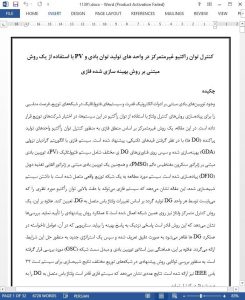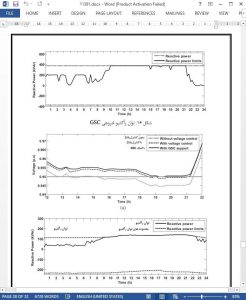Abstract
The presence of power electronic-based wind turbines and photovoltaic systems in distribution networks has provided distribution companies an opportunity to implement voltage control through using the reactive power of these systems. In this paper, a decentralized method based on fuzzy logic is proposed to control the reactive power of distributed generations (DGs) regarding the technical constraints. The fuzzy system is optimized by gradient descent algorithm (GDA) and then implemented on various DG technologies including a photovoltaic (PV) system, permanent magnet synchronous generator (PMSG) wind turbine and also a doubly fed induction generator (DFIG) wind turbine. The system under study is tied to a real distribution network. Having simulated the system, the paper shows that the fuzzy system can appropriately determine the desired reactive power that should be produced by each DG based on the voltage variation of the bus at which the DG is connected. Furthermore, a centralized voltage control is also applied to the same network to verify the performance of the method proposed. The verification indicates that the method is capable of finding the near-optimal solution. A scenario in which an unwanted conflict appears in the DGs’ function is defined in detail and then a strategy is presented to resolve the situation. In addition to this, the coordination between the stator of the wind turbines and grid side converter (GSC) is examined. To investigate the robustness of the proposed method in different distribution networks, simulation results are also presented for IEEE 33-bus distribution test system. The numerical results show that the fuzzy system can effectively control the voltage of the DG connection bus.
1. Introduction
Most of the distributed generations (DGs) use inverters to connect to the power grid such as photovoltaic (PV) systems, wind turbines with full-power converters and wind turbines made up with doubly fed induction generators (DFIG). These DG technologies have become very popular for their benefits and now they are a part of the distribution systems [1]. DGs can supply the load active and reactive power locally, which results in a reduction in line losses [2]. Also, voltage and stability of the power system can be improved by integrating DG into the power grid [3]. An interesting feature of inverter-based DGs is their capability of reactive power control and some grid codes now require that PV systems and wind turbines participate in reactive power control of the power system [4]. To comply with new grid codes, solar inverter manufacturers are presenting their photovoltaic inverters with reactive power control capability.
5. Conclusions
In this paper, a decentralized method is used for reactive power control of PV systems and wind turbines with the aim to regulate DG bus voltage. The proposed method is based on a fuzzy system that its membership functions are optimized by the gradient descent algorithm. The reactive power capability of PV systems, PMSG wind turbines, and DFIG wind turbines are considered in the voltage control. The simulations are conducted in a real 54 bus distribution system during a typical day, a summer day and a winter day. To evaluate the performance of the fuzzy control system, a centralized method based on the PSO is also performed to obtain the optimal reactive power output of the DGs. The fuzzy control system is also applied to the IEEE 33 bus distribution network to show the robustness of the proposed method.











